Continuing my series of posts of my pictures from 1978 which will eventually include all of the selected photographs I took in London in 1978 and posted recently on Facebook with comments, and a few related images. All of these pictures (and more) are in my London Pictures web site, and eventually I intend to add the comments there too.
Click on any image to go to the web page with a slightly larger picture.
__________________________________________
London 1978 (4)
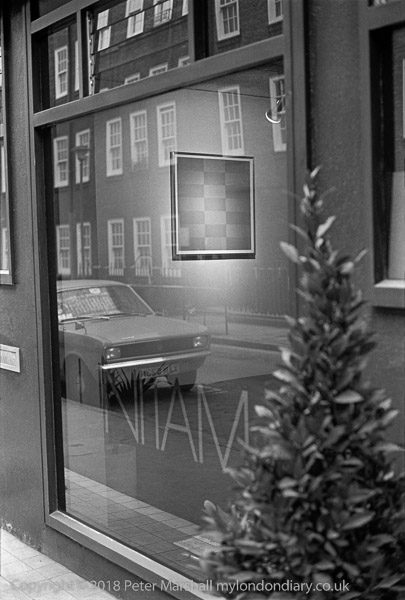
Shopfront and reflection, Covent Garden, Westminster, 1978
14c25: westminster
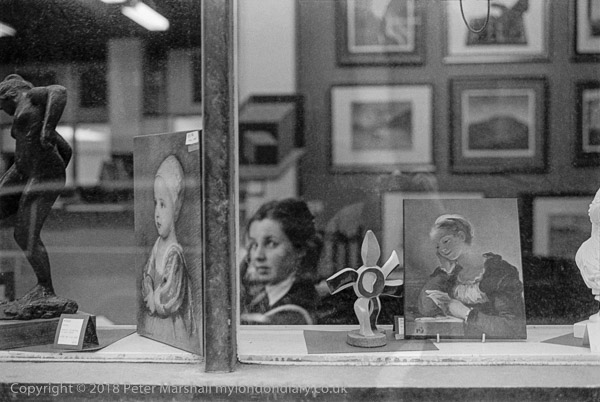
Shop Window with woman, Covent Garden, Westminster, 1978
14c32: westminster, shop, art, art dealer, gallery, woman
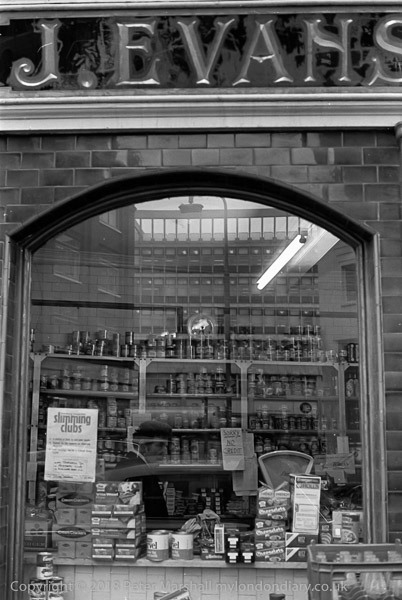
J Evans, Diary, Warren St, Camden, 1978
14d35: camden, shop, diary, shop window
The only one of my grandparents I remember was a small elderly woman dressed in black with very strict rules, particularly on Sundays, when we were not allowed to play but had to read improving books. She sat in the corner by the fire, where a smoke-blackened kettle always stood. She didn’t say much and didn’t like children to make much noise either.
At Christmas we would all get together for a family meal around a large table in the front room, seldom used for the rest of the year, where all except me would eat goose, sent up from the family farm by train to Paddington where one of my uncles would go to collect it the day before. I found goose far to greasy and instead gorged on the chipolatas and bacon from the local butcher.
My grandmother had been born Eliza Ann Davies in Llansaintfread in mid-Wales on Boxing Day in 1865, so the Christmas meal was a joint celebration. She had met my grandfather who came from Essex but moved to London to work when she, like many young Welsh girls had also come up to work in London, perhaps in a shop like this, perhaps the family dairy shop, somewhere long gone on the Gray’s Inn Road. London dairies would sell produce sent from Wales by train, but also might have a cow or two kept in the back yard. Not far away there is still the London Welsh Centre (“The world’s only Welsh cultural centre”, though it only opened there in 1937) and the 1854 Welsh Tabernacle (Eglwys y Tabernaacl) Grade II listed and still standing, though now Ethiopian rather than Welsh.
The shop in the picture, J Evans, on the corner of Conway St and Warren St is Grade II listed and was built around 1793, though the shop front dates from around 1916, when J Evans, dairyman, is recorded as having arrived here, presumably with a cow or two. It was more a small general store when I took this picture (along with others, mainly in colour which show up the beautiful blue of the tiles and surrounding the gold lettering) and is now the Old Diary coffee shop.
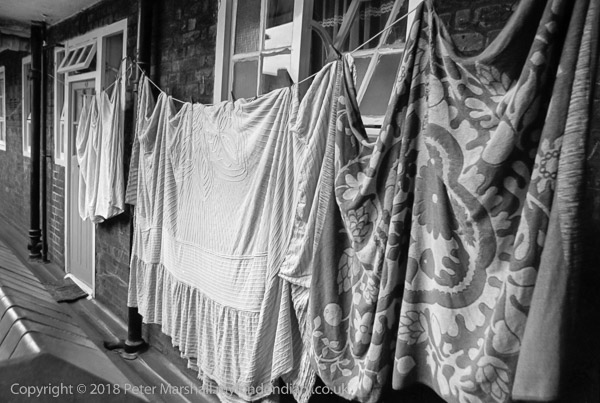
Washing on balcony, Key House, Lambeth, 1978
14i43: lambeth, vauxhall, council flat, flat, balcony, washing
Key House on Bowling Green St, not far from the Oval was where friends we often visited lived in a shared flat. It was one of Lambeth Council’s hard to let properties that were advertised and eligible local residents and workers could queue to get, an overnight vigil to be near enough to the front of the queue.
Built around 1930, when both the London County Council and the Metropolitan Borough of Lambeth where building large blocks in the area to provide low cost accommodation for the working class poor. The rent for their 3-bed flat would probably have been around 12 shillings (60p) a week. The flats were built to relatively high standards, providing some of those moving into them when new for the first time with a scullery, bathroom and toilet in their home. The rooms too were rather larger than in many of the ‘luxury’ flats now being built, and similar flats in this block have sold recently for over £400,000.
Some things were of course not up to modern standards, particularly the single-glazed draughty windows, and central heating was at that time unknown. Living rooms had a coal fire and bedrooms were usually unheated, though they might have had fireplaces. But the flats they were solidly built, with brick walls that provided better insulation than many postwar system built flats.
What let them down over the years was maintenance and the cleaning of the communal areas – the balconies, laundry rooms, stair cases, rubbish chutes and courtyards. The council made some attempt to improve them in the 80s and 90s, fitting doors at the entrance to the stairs, but many residents found these a nuisance and some locks were broken and other doors wedged permanently open in the years until all our friends moved out. If one stair was locked you could usually find another open and walk around on the balcony.
There were still communal laundry rooms, and still a mangle in the one next to our friend’s flat, but most people by then had some kind of washing machine in their own flats, but they still hung their washing out along the balconies.
Everything coming into the flats had to come in up the stairs, and there were five floors; fortunately my friends were only on the second but helping to get a piano up the two flights to store in the laundry room left me with painful back for several weeks.
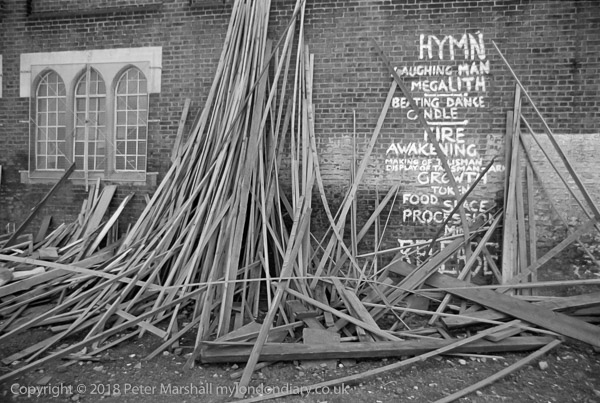
Writing on Wall, Vauxhall City Farm, Lambeth, 1978
14i34: lambeth, vauxhall, city farm, farm, poem, hymn
The building at the City farm was some kind of former school at the back of St Peter’s Church which included the 1861 Lambeth School of Art. We organised some meeting in this building to which almost nobody came and there was no heating on a desperately cold winter day and we froze even in our outside coats.
The church, Grade II* listed and consecrated in 1864 though its tower was never built, and the city farm are both on the site of Vauxhall Gardens, a notorious Georgian pleasure ground where great festivals took place, along with many amorous encounters in the darker wooded corners; the church itself was on the site which once had a Moorish tower built as a firework platform in 1823 which burnt down 14 years later and a dimly lit ‘Lovers Walk’, and the art school on St Oswald’s Place on the site of the Vauxhall Garden’s famous Neptune Fountain, his marine chariot drawn by five horses from whose nostrils water, steam and even flames would emerge.
Once I went to a service in the church, whose magnificent interior is well worth a visit and there are regular concerts there. We went to a service there, a small group of people on chairs in the middle of a large building, led by a young priest in black leathers.
Make what you can of the writing on the wall, part-hidden by the stacked wood – and I think left from an earlier event. I think it reads:
HYMN
LAUGHING MAN
MEGALITH
—-
BEATING DANCE
CANDLE
—-
FIRE
AWAKENING
MAKING OF TALISMAN
DISPLAY OF TALISMAN-ARK
GROWTH
TOKEN
FOOD
SPACE
PROCESSION
MIND
RELEASE
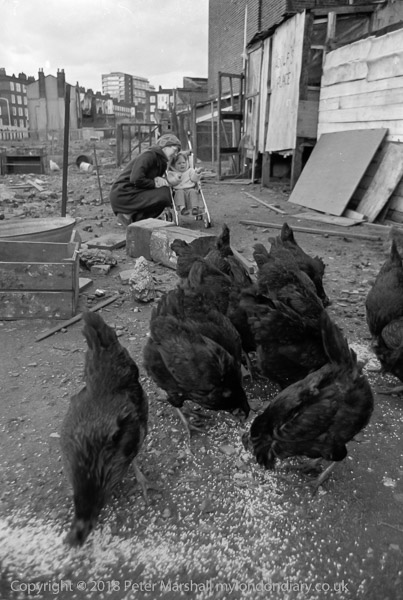
Vauxhall City Farm, Lambeth, 1978
14i31: lambeth, vauxhall, city farm, farm, chickens, people
Another picture from Vauxhall City Farm, this time a chicken’s eye view of my wife and son looking at them.
Good to have the houses and flats in the background which shows clearly this is a city farm.
This was not long after the farm was founded in 1976 as Jubilee City Farm by a group who were squatting in St Ostwald’s Place. The farm is still going in Tyers Place, but unrecognisable from those early days when it was run on a shoe-string by a few local enthusiasts and volunteers.

Vauxhall City Farm, Lambeth, 1978
14i21: lambeth, vauxhall, city farm, farm, goats, people
A group of our friends lived in a council flat in Key House in Kennington and we went with them to Vauxhall City Farm, which one of them was very involved in, and I’ve put several pictures from the visit on-line.
Usually I like – other things being equal – to work from a normal eye level, it fitting in with my ideas about a naturalistic approach to the medium. Its the viewpoint from which we mainly see things. And these days if I climb up on anything I’m likely to get the shakes, while if I get low down its sometimes rather an effort to get up. I suspect I took this picture from a ladder rather like the one in the picture, presumable there to allow those looking after the goats to easily access their enclosure. Though there isn’t one on the other side to allow them to get out, perhaps because the goats might take advantage of it.
At bottom left you can see the head of my wife and our then two-year old son in a buggy looking at the goats, and the two women were I think both among our visiting party. The fence wasn’t quite dividing the sheep from the goats, but this did come into my mind and still does whenever I see this picture.
More to follow….
______________________________________________________
There are no adverts on this site and it receives no
sponsorship, and I like to keep it that way. But it does take a considerable amount of my time and thought, and if you enjoy reading it, a small donation – perhaps the cost of a beer – would be appreciated.
My London Diary : London Photos : Hull : River Lea/Lee Valley : London’s Industrial Heritage
All photographs on this and my other sites, unless otherwise stated, are taken by and copyright of Peter Marshall, and are available for reproduction or can be bought as prints.
To order prints or reproduce images
________________________________________________________